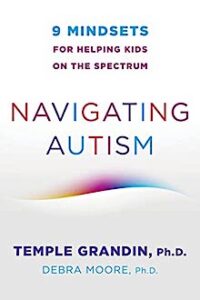9 Mindsets for Helping Kids on the Spectrum
Navigating Autism: 9 Mindsets for Helping Kids on the Spectrum
By Temple Grandin, Ph.D. and Debra Moore, Ph.D.
(Norton, 2021 – Learn more)
Reviewed by Bill Ivey

Both collectively, through presentations in our all-school housemeetings, and individually, through personal advocacy, they are helping us better understand and support the range of ways of being and learning of all our students.
Our middle school team has made it a goal for next year to better understand the ways in which we are serving our neurodivergent students well and identify where and how we need to improve.
In this context, Navigating Autism 9 Mindsets for Helping Kids on the Spectrum made a perfect book for my summer PD reading. After a brief preface by Dr. Grandin and a brief introduction by Dr. Moore, the book dives immediately into the first of the nine mindsets, “Every child is more than autism.”
Familiar territory and new information

That filter can cause us to misinterpret key information and/or to miss it altogether. Further leading us to inadvertently fall into a “label trap” (p.2) are the influence of media (p.3), overreliance on narrow lists of diagnostic criteria (p.3), and failing to pay attention to “all aspects of a child.” (p.4)
All of us have four natural human tendencies: “We like simple explanations of a child’s behavior, and we ignore contradictory data” (p.11), “We tend to assume what we observe happens all the time, in all situations” (p.14), “We tend to artificially integrate divergent traits and behaviors into a unified narrative” (p.20), and “We tend to explain away data that makes us uncomfortable or we can’t make sense of” (p.25).
The authors share specific tips to help us “appreciate a child’s unique and varied nuances” (p.12), “distinguish between temporary states and stable states” (p.16), “gather a more complete picture of a child” (p.23) and “use all observations of a child for their benefit” (p.27). Ultimately, we need to ensure we “embed the label within a full depiction of the person” (p.7).
From childhood to young adulthood
The book is written for multiple audiences including general physicians, medical specialists, clinicians, educators, and parents. It covers kids’ needs from early childhood through young adulthood. Accordingly, some sections will relate more to middle school teachers than others. That said, I found it worth reading all sections – in particular because we play an important role in a support team and because our observations can form an important part of the whole.
Each section of the book explains one of the mindsets, often explicitly connecting back to the first that “every child is more than autism,” and provides both positive examples of how to act within the mindset and negative examples of what happens when we don’t, in some instances through case studies.
There are also countless lists of tips that can be helpful in different ways to all audiences for the book. Finally, each chapter ends with a summary.
The full list of nine mindsets includes:
- Every child is more than autism
- Whole child evaluations are vital
- Take these steps before beginning any intervention
- Know these medical conditions associated with autism
- Know these psychiatric conditions associated with autism
- Prepare kids for the real world
- Focus on strengths, not deficits
- Work in the growth zone
- Envisioning a successful adulthood
Many of these, of course, are already familiar to effective educators. We recognize the importance of focusing on the whole child, of working to stretch students out but not too far out of their comfort zone to maximize learning, and of recognizing and building on each student’s strengths.
Mindsets to help all students
Much as classroom teaching that works to meet the needs of Black students and other students of color also helps white students – and classroom teaching that works to meet the needs of LGBTQ+ students also helps cisgender heterosexual students – working to meet the needs of neurodivergent students including kids with autism can not only help us better meet the specific needs of kids with autism but also help us better meet the needs of all students, including neurotypical kids. This book can help us move well down that path.
I am optimistic this book will make me a better teacher and better team member, exactly the goals I had in mind when I picked it up.
Bill Ivey (he/any) is Middle School Dean and teaches Humanities 7, Rock Band, and Academic Skills at Stoneleigh-Burnham School, a gender inclusive girls school for grades 7-12 in Western Massachusetts. He also serves on the NELMS Board of the Directors as an advisor for equity, inclusion, and social justice, and on the AMLE Equity in Middle Grades Education Committee. See Bill’s other MiddleWeb reviews and articles here.

































